University Experimental Report: Aging and Memory Span in Psychology
VerifiedAdded on 2022/08/15
|23
|2875
|178
Report
AI Summary
This experimental report investigates the effects of aging on memory span, addressing the research question: Does age detrimentally affect memory span? The study employed a 2x2 experimental design, examining memory performance in younger and older adults using both within-subjects and between-subjects approaches. Participants were presented with stimuli, and their response times were recorded. The report includes an introduction discussing relevant theories and previous research, followed by a detailed methodology section outlining the experimental design, procedure, participants, and materials used. The results section presents statistical analyses, including descriptive statistics, multivariate tests, and tests of within-subjects effects. The discussion section interprets the findings, concluding that there is a linear correlation between response time and accuracy and that younger adults exhibit higher cognitive capabilities compared to older adults. The report includes an appendix with the statistical output and references to support the research.
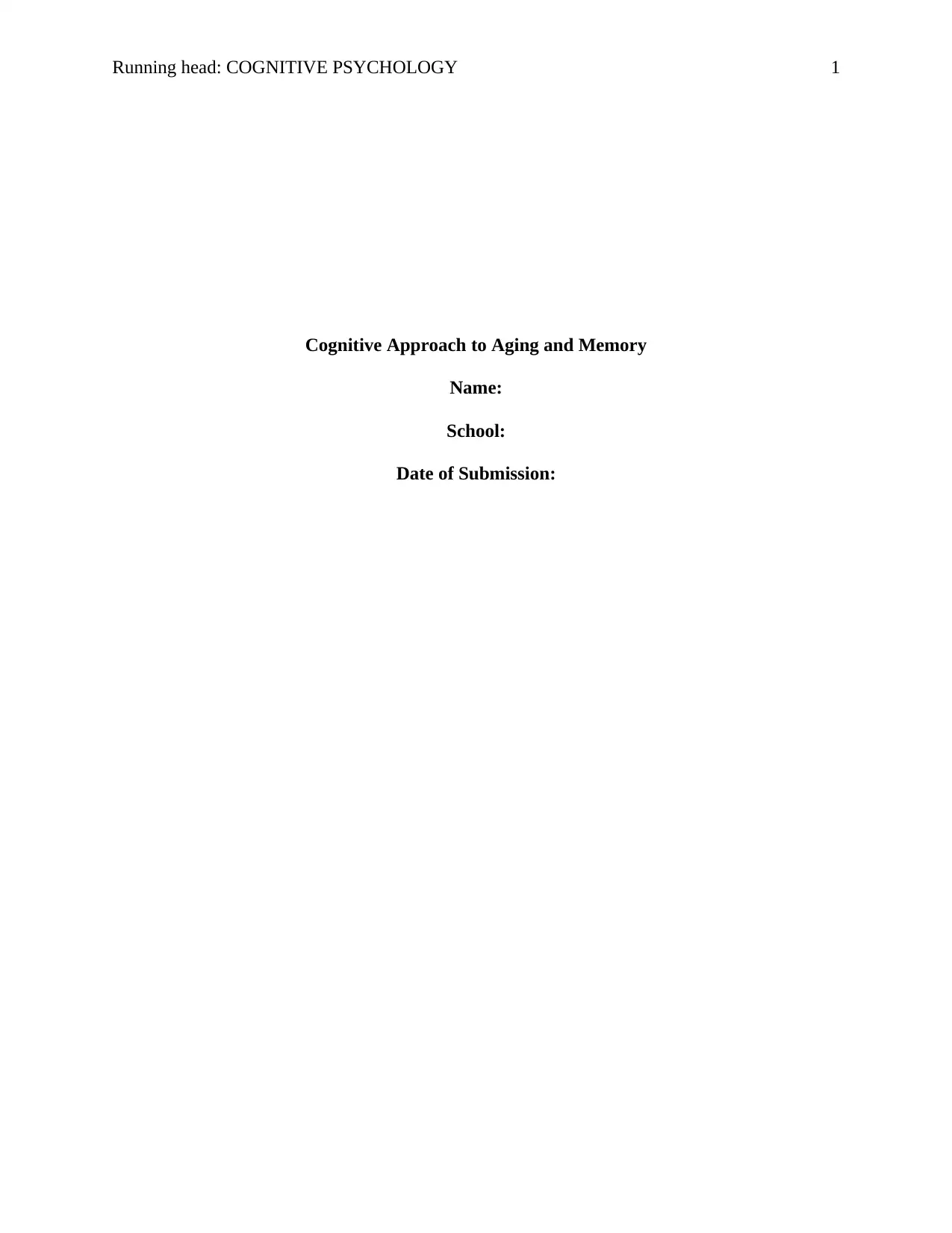
Running head: COGNITIVE PSYCHOLOGY 1
Cognitive Approach to Aging and Memory
Name:
School:
Date of Submission:
Cognitive Approach to Aging and Memory
Name:
School:
Date of Submission:
Paraphrase This Document
Need a fresh take? Get an instant paraphrase of this document with our AI Paraphraser
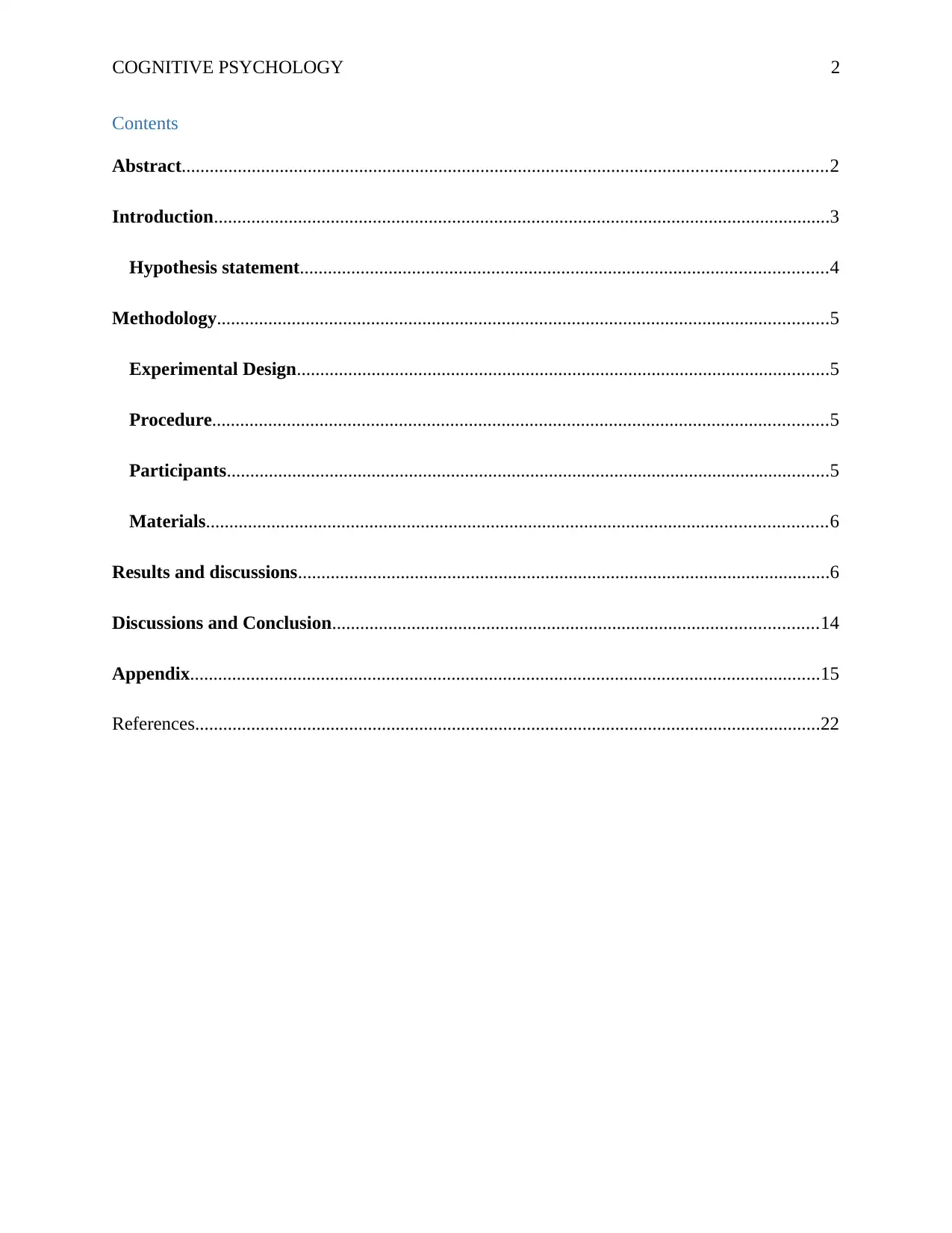
COGNITIVE PSYCHOLOGY 2
Contents
Abstract..........................................................................................................................................2
Introduction....................................................................................................................................3
Hypothesis statement.................................................................................................................4
Methodology...................................................................................................................................5
Experimental Design..................................................................................................................5
Procedure....................................................................................................................................5
Participants.................................................................................................................................5
Materials.....................................................................................................................................6
Results and discussions..................................................................................................................6
Discussions and Conclusion........................................................................................................14
Appendix.......................................................................................................................................15
References......................................................................................................................................22
Contents
Abstract..........................................................................................................................................2
Introduction....................................................................................................................................3
Hypothesis statement.................................................................................................................4
Methodology...................................................................................................................................5
Experimental Design..................................................................................................................5
Procedure....................................................................................................................................5
Participants.................................................................................................................................5
Materials.....................................................................................................................................6
Results and discussions..................................................................................................................6
Discussions and Conclusion........................................................................................................14
Appendix.......................................................................................................................................15
References......................................................................................................................................22
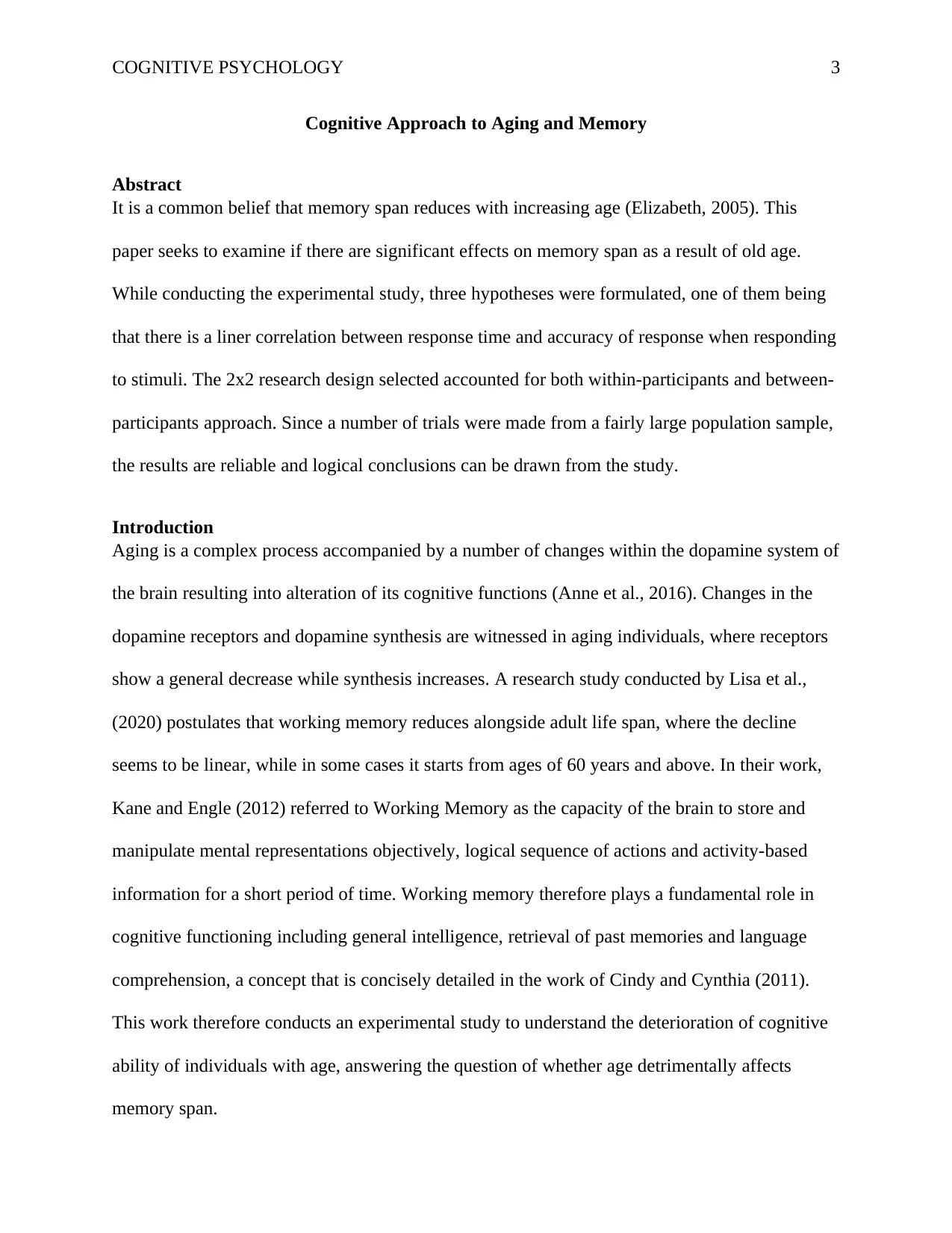
COGNITIVE PSYCHOLOGY 3
Cognitive Approach to Aging and Memory
Abstract
It is a common belief that memory span reduces with increasing age (Elizabeth, 2005). This
paper seeks to examine if there are significant effects on memory span as a result of old age.
While conducting the experimental study, three hypotheses were formulated, one of them being
that there is a liner correlation between response time and accuracy of response when responding
to stimuli. The 2x2 research design selected accounted for both within-participants and between-
participants approach. Since a number of trials were made from a fairly large population sample,
the results are reliable and logical conclusions can be drawn from the study.
Introduction
Aging is a complex process accompanied by a number of changes within the dopamine system of
the brain resulting into alteration of its cognitive functions (Anne et al., 2016). Changes in the
dopamine receptors and dopamine synthesis are witnessed in aging individuals, where receptors
show a general decrease while synthesis increases. A research study conducted by Lisa et al.,
(2020) postulates that working memory reduces alongside adult life span, where the decline
seems to be linear, while in some cases it starts from ages of 60 years and above. In their work,
Kane and Engle (2012) referred to Working Memory as the capacity of the brain to store and
manipulate mental representations objectively, logical sequence of actions and activity-based
information for a short period of time. Working memory therefore plays a fundamental role in
cognitive functioning including general intelligence, retrieval of past memories and language
comprehension, a concept that is concisely detailed in the work of Cindy and Cynthia (2011).
This work therefore conducts an experimental study to understand the deterioration of cognitive
ability of individuals with age, answering the question of whether age detrimentally affects
memory span.
Cognitive Approach to Aging and Memory
Abstract
It is a common belief that memory span reduces with increasing age (Elizabeth, 2005). This
paper seeks to examine if there are significant effects on memory span as a result of old age.
While conducting the experimental study, three hypotheses were formulated, one of them being
that there is a liner correlation between response time and accuracy of response when responding
to stimuli. The 2x2 research design selected accounted for both within-participants and between-
participants approach. Since a number of trials were made from a fairly large population sample,
the results are reliable and logical conclusions can be drawn from the study.
Introduction
Aging is a complex process accompanied by a number of changes within the dopamine system of
the brain resulting into alteration of its cognitive functions (Anne et al., 2016). Changes in the
dopamine receptors and dopamine synthesis are witnessed in aging individuals, where receptors
show a general decrease while synthesis increases. A research study conducted by Lisa et al.,
(2020) postulates that working memory reduces alongside adult life span, where the decline
seems to be linear, while in some cases it starts from ages of 60 years and above. In their work,
Kane and Engle (2012) referred to Working Memory as the capacity of the brain to store and
manipulate mental representations objectively, logical sequence of actions and activity-based
information for a short period of time. Working memory therefore plays a fundamental role in
cognitive functioning including general intelligence, retrieval of past memories and language
comprehension, a concept that is concisely detailed in the work of Cindy and Cynthia (2011).
This work therefore conducts an experimental study to understand the deterioration of cognitive
ability of individuals with age, answering the question of whether age detrimentally affects
memory span.
⊘ This is a preview!⊘
Do you want full access?
Subscribe today to unlock all pages.

Trusted by 1+ million students worldwide
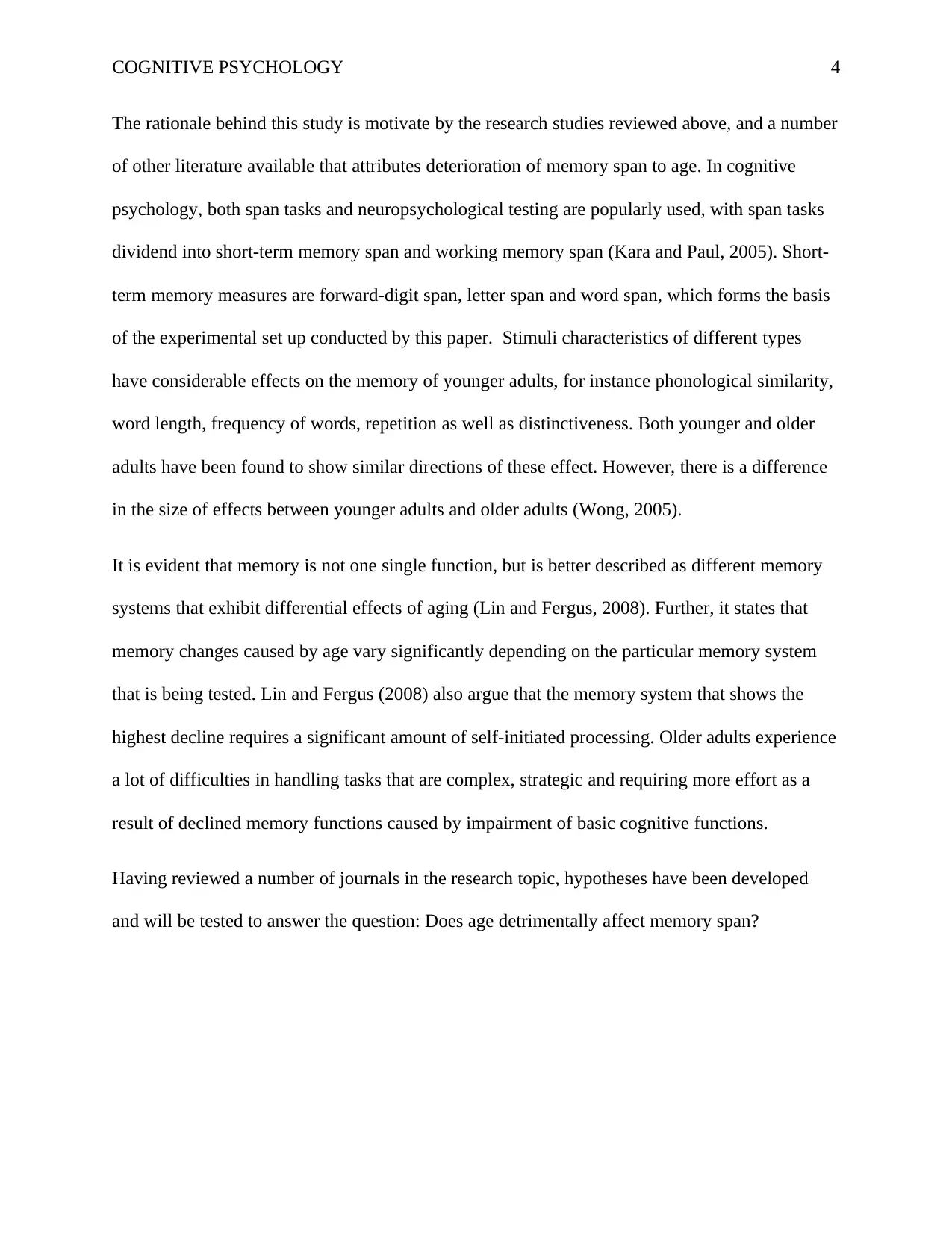
COGNITIVE PSYCHOLOGY 4
The rationale behind this study is motivate by the research studies reviewed above, and a number
of other literature available that attributes deterioration of memory span to age. In cognitive
psychology, both span tasks and neuropsychological testing are popularly used, with span tasks
dividend into short-term memory span and working memory span (Kara and Paul, 2005). Short-
term memory measures are forward-digit span, letter span and word span, which forms the basis
of the experimental set up conducted by this paper. Stimuli characteristics of different types
have considerable effects on the memory of younger adults, for instance phonological similarity,
word length, frequency of words, repetition as well as distinctiveness. Both younger and older
adults have been found to show similar directions of these effect. However, there is a difference
in the size of effects between younger adults and older adults (Wong, 2005).
It is evident that memory is not one single function, but is better described as different memory
systems that exhibit differential effects of aging (Lin and Fergus, 2008). Further, it states that
memory changes caused by age vary significantly depending on the particular memory system
that is being tested. Lin and Fergus (2008) also argue that the memory system that shows the
highest decline requires a significant amount of self-initiated processing. Older adults experience
a lot of difficulties in handling tasks that are complex, strategic and requiring more effort as a
result of declined memory functions caused by impairment of basic cognitive functions.
Having reviewed a number of journals in the research topic, hypotheses have been developed
and will be tested to answer the question: Does age detrimentally affect memory span?
The rationale behind this study is motivate by the research studies reviewed above, and a number
of other literature available that attributes deterioration of memory span to age. In cognitive
psychology, both span tasks and neuropsychological testing are popularly used, with span tasks
dividend into short-term memory span and working memory span (Kara and Paul, 2005). Short-
term memory measures are forward-digit span, letter span and word span, which forms the basis
of the experimental set up conducted by this paper. Stimuli characteristics of different types
have considerable effects on the memory of younger adults, for instance phonological similarity,
word length, frequency of words, repetition as well as distinctiveness. Both younger and older
adults have been found to show similar directions of these effect. However, there is a difference
in the size of effects between younger adults and older adults (Wong, 2005).
It is evident that memory is not one single function, but is better described as different memory
systems that exhibit differential effects of aging (Lin and Fergus, 2008). Further, it states that
memory changes caused by age vary significantly depending on the particular memory system
that is being tested. Lin and Fergus (2008) also argue that the memory system that shows the
highest decline requires a significant amount of self-initiated processing. Older adults experience
a lot of difficulties in handling tasks that are complex, strategic and requiring more effort as a
result of declined memory functions caused by impairment of basic cognitive functions.
Having reviewed a number of journals in the research topic, hypotheses have been developed
and will be tested to answer the question: Does age detrimentally affect memory span?
Paraphrase This Document
Need a fresh take? Get an instant paraphrase of this document with our AI Paraphraser
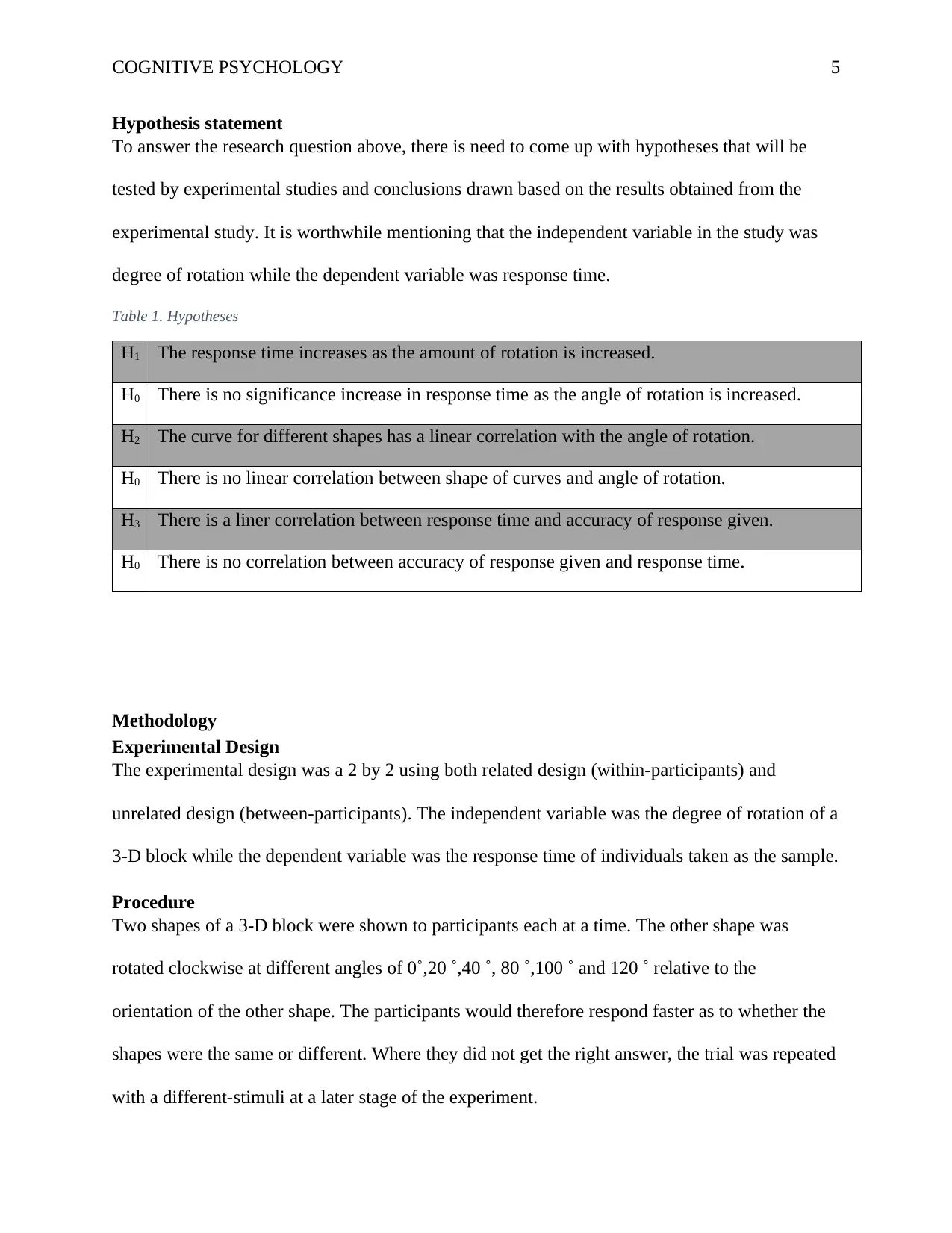
COGNITIVE PSYCHOLOGY 5
Hypothesis statement
To answer the research question above, there is need to come up with hypotheses that will be
tested by experimental studies and conclusions drawn based on the results obtained from the
experimental study. It is worthwhile mentioning that the independent variable in the study was
degree of rotation while the dependent variable was response time.
Table 1. Hypotheses
H1 The response time increases as the amount of rotation is increased.
H0 There is no significance increase in response time as the angle of rotation is increased.
H2 The curve for different shapes has a linear correlation with the angle of rotation.
H0 There is no linear correlation between shape of curves and angle of rotation.
H3 There is a liner correlation between response time and accuracy of response given.
H0 There is no correlation between accuracy of response given and response time.
Methodology
Experimental Design
The experimental design was a 2 by 2 using both related design (within-participants) and
unrelated design (between-participants). The independent variable was the degree of rotation of a
3-D block while the dependent variable was the response time of individuals taken as the sample.
Procedure
Two shapes of a 3-D block were shown to participants each at a time. The other shape was
rotated clockwise at different angles of 0˚,20 ˚,40 ˚, 80 ˚,100 ˚ and 120 ˚ relative to the
orientation of the other shape. The participants would therefore respond faster as to whether the
shapes were the same or different. Where they did not get the right answer, the trial was repeated
with a different-stimuli at a later stage of the experiment.
Hypothesis statement
To answer the research question above, there is need to come up with hypotheses that will be
tested by experimental studies and conclusions drawn based on the results obtained from the
experimental study. It is worthwhile mentioning that the independent variable in the study was
degree of rotation while the dependent variable was response time.
Table 1. Hypotheses
H1 The response time increases as the amount of rotation is increased.
H0 There is no significance increase in response time as the angle of rotation is increased.
H2 The curve for different shapes has a linear correlation with the angle of rotation.
H0 There is no linear correlation between shape of curves and angle of rotation.
H3 There is a liner correlation between response time and accuracy of response given.
H0 There is no correlation between accuracy of response given and response time.
Methodology
Experimental Design
The experimental design was a 2 by 2 using both related design (within-participants) and
unrelated design (between-participants). The independent variable was the degree of rotation of a
3-D block while the dependent variable was the response time of individuals taken as the sample.
Procedure
Two shapes of a 3-D block were shown to participants each at a time. The other shape was
rotated clockwise at different angles of 0˚,20 ˚,40 ˚, 80 ˚,100 ˚ and 120 ˚ relative to the
orientation of the other shape. The participants would therefore respond faster as to whether the
shapes were the same or different. Where they did not get the right answer, the trial was repeated
with a different-stimuli at a later stage of the experiment.
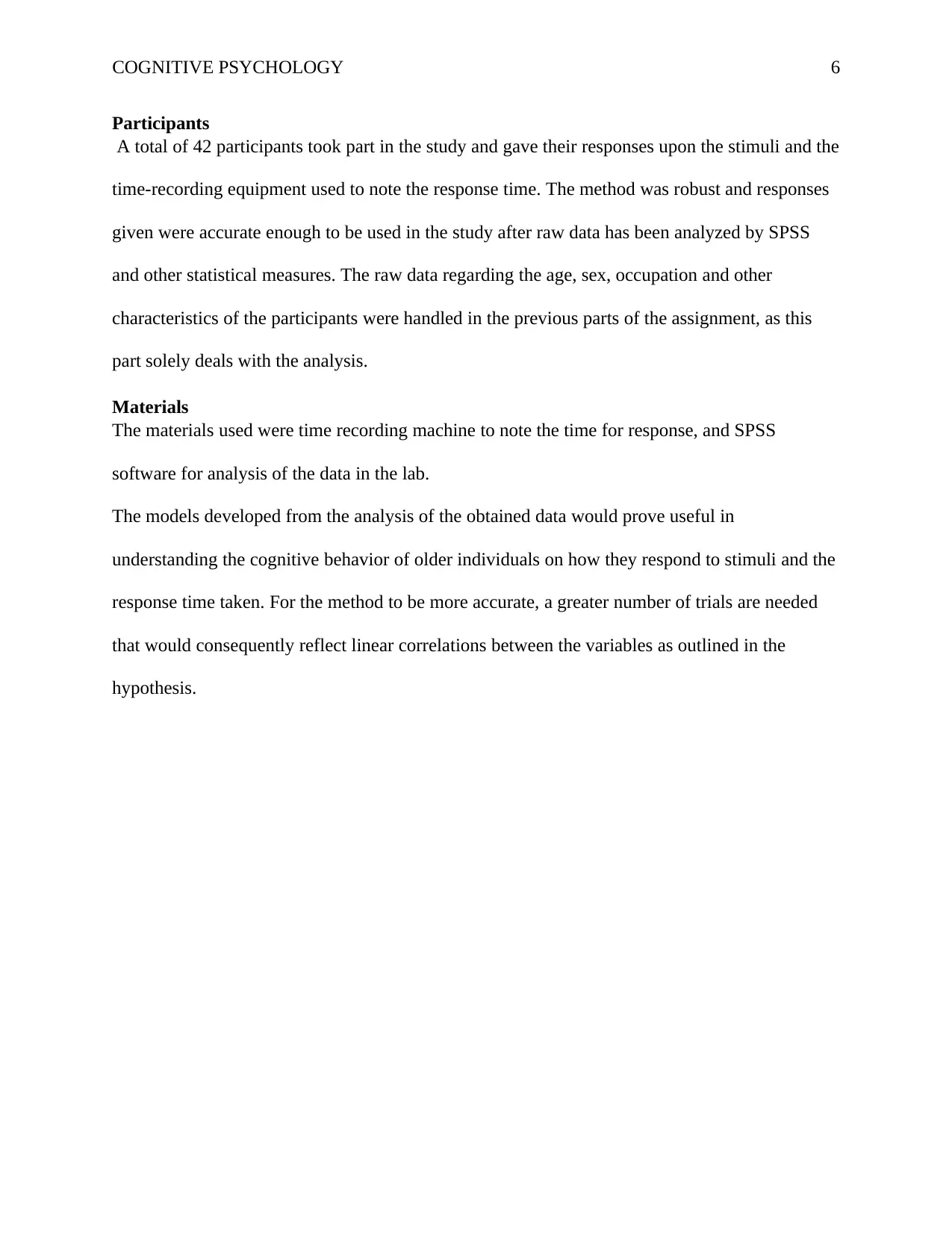
COGNITIVE PSYCHOLOGY 6
Participants
A total of 42 participants took part in the study and gave their responses upon the stimuli and the
time-recording equipment used to note the response time. The method was robust and responses
given were accurate enough to be used in the study after raw data has been analyzed by SPSS
and other statistical measures. The raw data regarding the age, sex, occupation and other
characteristics of the participants were handled in the previous parts of the assignment, as this
part solely deals with the analysis.
Materials
The materials used were time recording machine to note the time for response, and SPSS
software for analysis of the data in the lab.
The models developed from the analysis of the obtained data would prove useful in
understanding the cognitive behavior of older individuals on how they respond to stimuli and the
response time taken. For the method to be more accurate, a greater number of trials are needed
that would consequently reflect linear correlations between the variables as outlined in the
hypothesis.
Participants
A total of 42 participants took part in the study and gave their responses upon the stimuli and the
time-recording equipment used to note the response time. The method was robust and responses
given were accurate enough to be used in the study after raw data has been analyzed by SPSS
and other statistical measures. The raw data regarding the age, sex, occupation and other
characteristics of the participants were handled in the previous parts of the assignment, as this
part solely deals with the analysis.
Materials
The materials used were time recording machine to note the time for response, and SPSS
software for analysis of the data in the lab.
The models developed from the analysis of the obtained data would prove useful in
understanding the cognitive behavior of older individuals on how they respond to stimuli and the
response time taken. For the method to be more accurate, a greater number of trials are needed
that would consequently reflect linear correlations between the variables as outlined in the
hypothesis.
⊘ This is a preview!⊘
Do you want full access?
Subscribe today to unlock all pages.

Trusted by 1+ million students worldwide
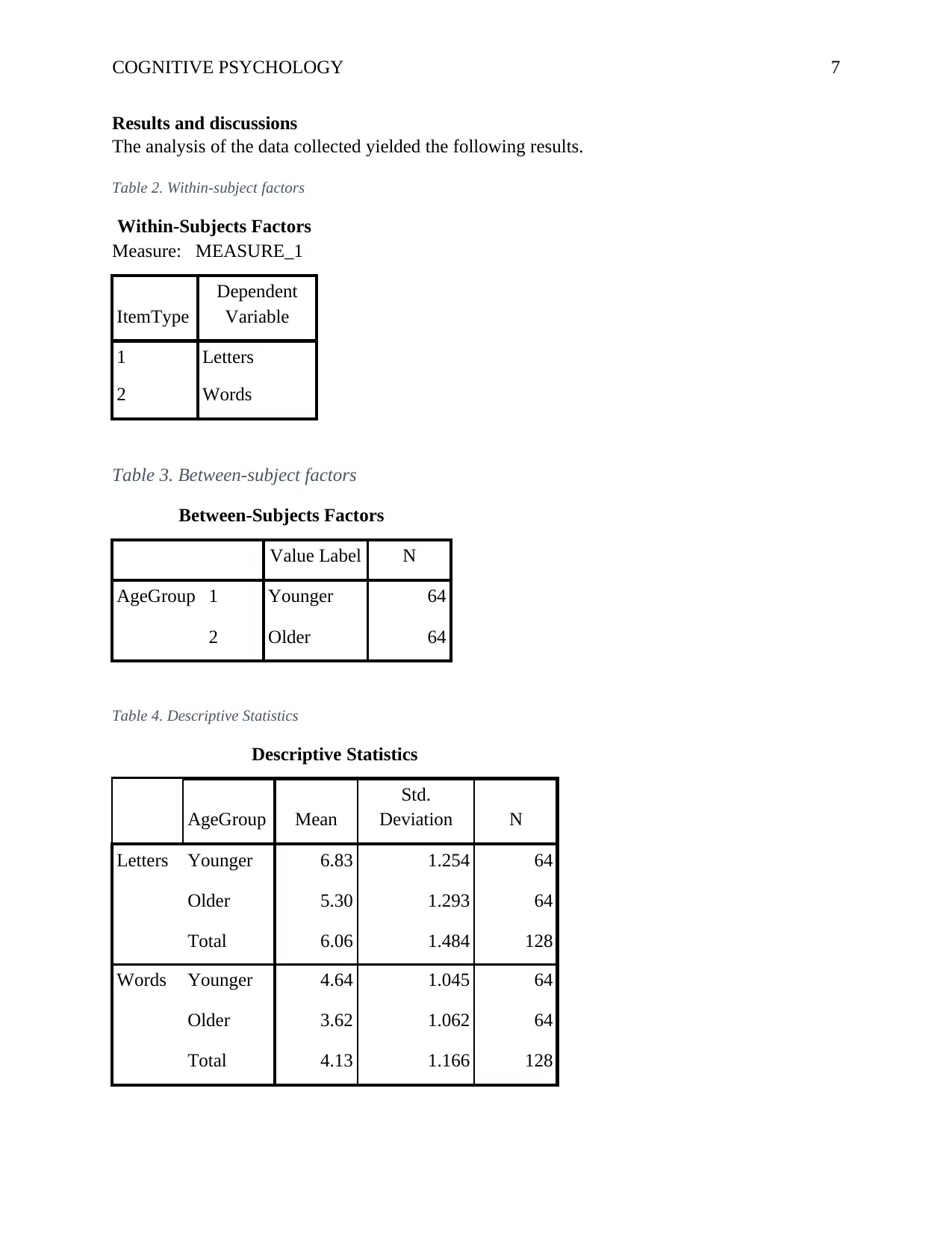
COGNITIVE PSYCHOLOGY 7
Results and discussions
The analysis of the data collected yielded the following results.
Table 2. Within-subject factors
Within-Subjects Factors
Measure: MEASURE_1
ItemType
Dependent
Variable
1 Letters
2 Words
Table 3. Between-subject factors
Between-Subjects Factors
Value Label N
AgeGroup 1 Younger 64
2 Older 64
Table 4. Descriptive Statistics
Descriptive Statistics
AgeGroup Mean
Std.
Deviation N
Letters Younger 6.83 1.254 64
Older 5.30 1.293 64
Total 6.06 1.484 128
Words Younger 4.64 1.045 64
Older 3.62 1.062 64
Total 4.13 1.166 128
Results and discussions
The analysis of the data collected yielded the following results.
Table 2. Within-subject factors
Within-Subjects Factors
Measure: MEASURE_1
ItemType
Dependent
Variable
1 Letters
2 Words
Table 3. Between-subject factors
Between-Subjects Factors
Value Label N
AgeGroup 1 Younger 64
2 Older 64
Table 4. Descriptive Statistics
Descriptive Statistics
AgeGroup Mean
Std.
Deviation N
Letters Younger 6.83 1.254 64
Older 5.30 1.293 64
Total 6.06 1.484 128
Words Younger 4.64 1.045 64
Older 3.62 1.062 64
Total 4.13 1.166 128
Paraphrase This Document
Need a fresh take? Get an instant paraphrase of this document with our AI Paraphraser

COGNITIVE PSYCHOLOGY 8
Table 5. Multivariate Tests
Multivariate Testsa
Effect Value F Hypothesis df Error df Sig.
ItemType Pillai's Trace .700 294.594b 1.000 126.000 .000
Wilks' Lambda .300 294.594b 1.000 126.000 .000
Hoteling’s Trace 2.338 294.594b 1.000 126.000 .000
Roy's Largest Root 2.338 294.594b 1.000 126.000 .000
ItemType *
AgeGroup
Pillai's Trace .040 5.258b 1.000 126.000 .023
Wilks' Lambda .960 5.258b 1.000 126.000 .023
Hoteling’s Trace .042 5.258b 1.000 126.000 .023
Roy's Largest Root .042 5.258b 1.000 126.000 .023
a. Design: Intercept + AgeGroup
Within Subjects Design: ItemType
b. Exact statistic
Mauchly's Test of Sphericitya
Measure: MEASURE_1
Within Subjects
Effect Mauchly's W
Approx. Chi-
Square df Sig.
Epsilonb
Greenhouse-
Geisser
Huynh-
Feldt
Lower-
bound
ItemType 1.000 .000 0 . 1.000 1.000 1.000
Tests the null hypothesis that the error covariance matrix of the orthonormalized transformed dependent
variables is proportional to an identity matrix.
a. Design: Intercept + AgeGroup
Within Subjects Design: ItemType
Table 5. Multivariate Tests
Multivariate Testsa
Effect Value F Hypothesis df Error df Sig.
ItemType Pillai's Trace .700 294.594b 1.000 126.000 .000
Wilks' Lambda .300 294.594b 1.000 126.000 .000
Hoteling’s Trace 2.338 294.594b 1.000 126.000 .000
Roy's Largest Root 2.338 294.594b 1.000 126.000 .000
ItemType *
AgeGroup
Pillai's Trace .040 5.258b 1.000 126.000 .023
Wilks' Lambda .960 5.258b 1.000 126.000 .023
Hoteling’s Trace .042 5.258b 1.000 126.000 .023
Roy's Largest Root .042 5.258b 1.000 126.000 .023
a. Design: Intercept + AgeGroup
Within Subjects Design: ItemType
b. Exact statistic
Mauchly's Test of Sphericitya
Measure: MEASURE_1
Within Subjects
Effect Mauchly's W
Approx. Chi-
Square df Sig.
Epsilonb
Greenhouse-
Geisser
Huynh-
Feldt
Lower-
bound
ItemType 1.000 .000 0 . 1.000 1.000 1.000
Tests the null hypothesis that the error covariance matrix of the orthonormalized transformed dependent
variables is proportional to an identity matrix.
a. Design: Intercept + AgeGroup
Within Subjects Design: ItemType
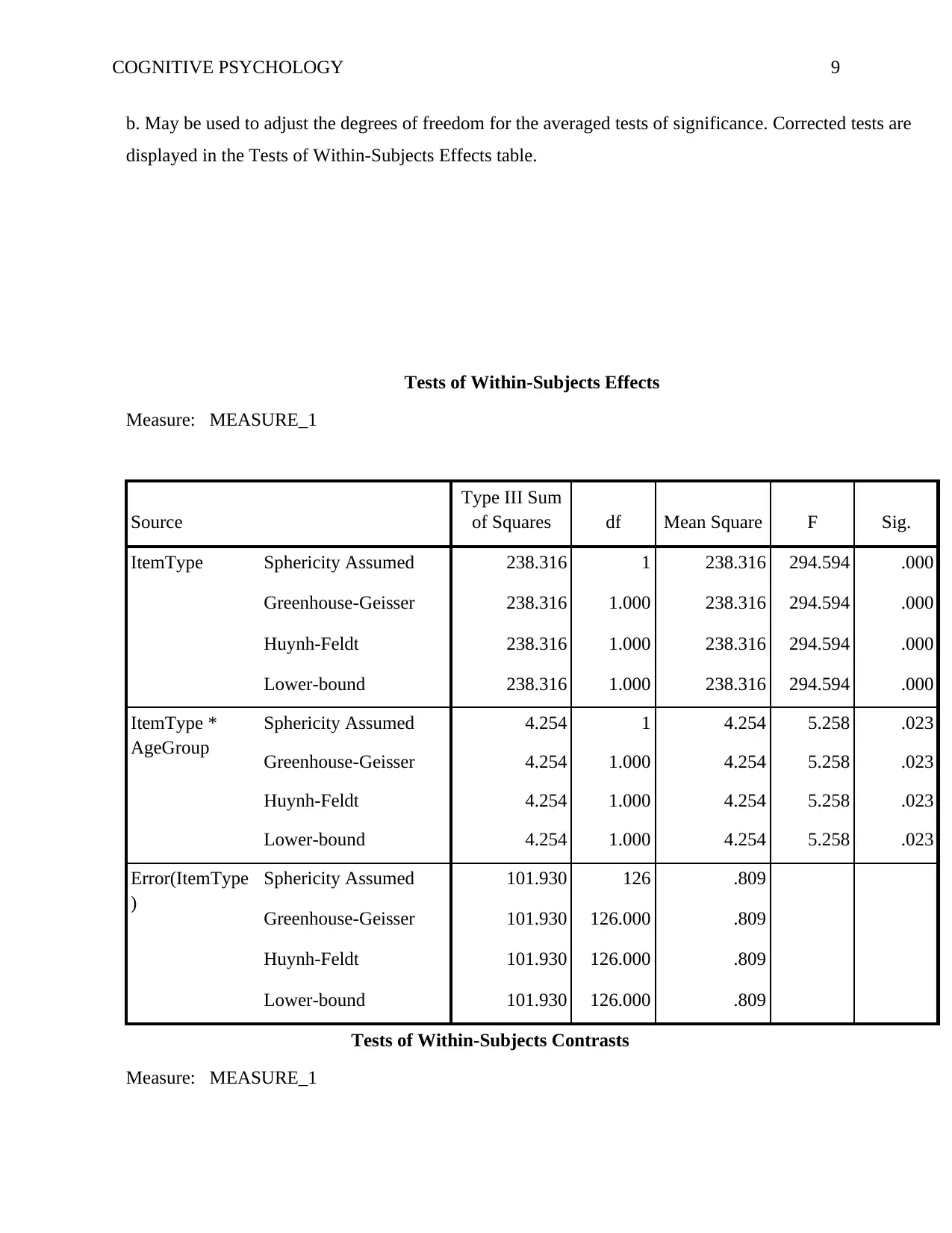
COGNITIVE PSYCHOLOGY 9
b. May be used to adjust the degrees of freedom for the averaged tests of significance. Corrected tests are
displayed in the Tests of Within-Subjects Effects table.
Tests of Within-Subjects Effects
Measure: MEASURE_1
Source
Type III Sum
of Squares df Mean Square F Sig.
ItemType Sphericity Assumed 238.316 1 238.316 294.594 .000
Greenhouse-Geisser 238.316 1.000 238.316 294.594 .000
Huynh-Feldt 238.316 1.000 238.316 294.594 .000
Lower-bound 238.316 1.000 238.316 294.594 .000
ItemType *
AgeGroup
Sphericity Assumed 4.254 1 4.254 5.258 .023
Greenhouse-Geisser 4.254 1.000 4.254 5.258 .023
Huynh-Feldt 4.254 1.000 4.254 5.258 .023
Lower-bound 4.254 1.000 4.254 5.258 .023
Error(ItemType
)
Sphericity Assumed 101.930 126 .809
Greenhouse-Geisser 101.930 126.000 .809
Huynh-Feldt 101.930 126.000 .809
Lower-bound 101.930 126.000 .809
Tests of Within-Subjects Contrasts
Measure: MEASURE_1
b. May be used to adjust the degrees of freedom for the averaged tests of significance. Corrected tests are
displayed in the Tests of Within-Subjects Effects table.
Tests of Within-Subjects Effects
Measure: MEASURE_1
Source
Type III Sum
of Squares df Mean Square F Sig.
ItemType Sphericity Assumed 238.316 1 238.316 294.594 .000
Greenhouse-Geisser 238.316 1.000 238.316 294.594 .000
Huynh-Feldt 238.316 1.000 238.316 294.594 .000
Lower-bound 238.316 1.000 238.316 294.594 .000
ItemType *
AgeGroup
Sphericity Assumed 4.254 1 4.254 5.258 .023
Greenhouse-Geisser 4.254 1.000 4.254 5.258 .023
Huynh-Feldt 4.254 1.000 4.254 5.258 .023
Lower-bound 4.254 1.000 4.254 5.258 .023
Error(ItemType
)
Sphericity Assumed 101.930 126 .809
Greenhouse-Geisser 101.930 126.000 .809
Huynh-Feldt 101.930 126.000 .809
Lower-bound 101.930 126.000 .809
Tests of Within-Subjects Contrasts
Measure: MEASURE_1
⊘ This is a preview!⊘
Do you want full access?
Subscribe today to unlock all pages.

Trusted by 1+ million students worldwide
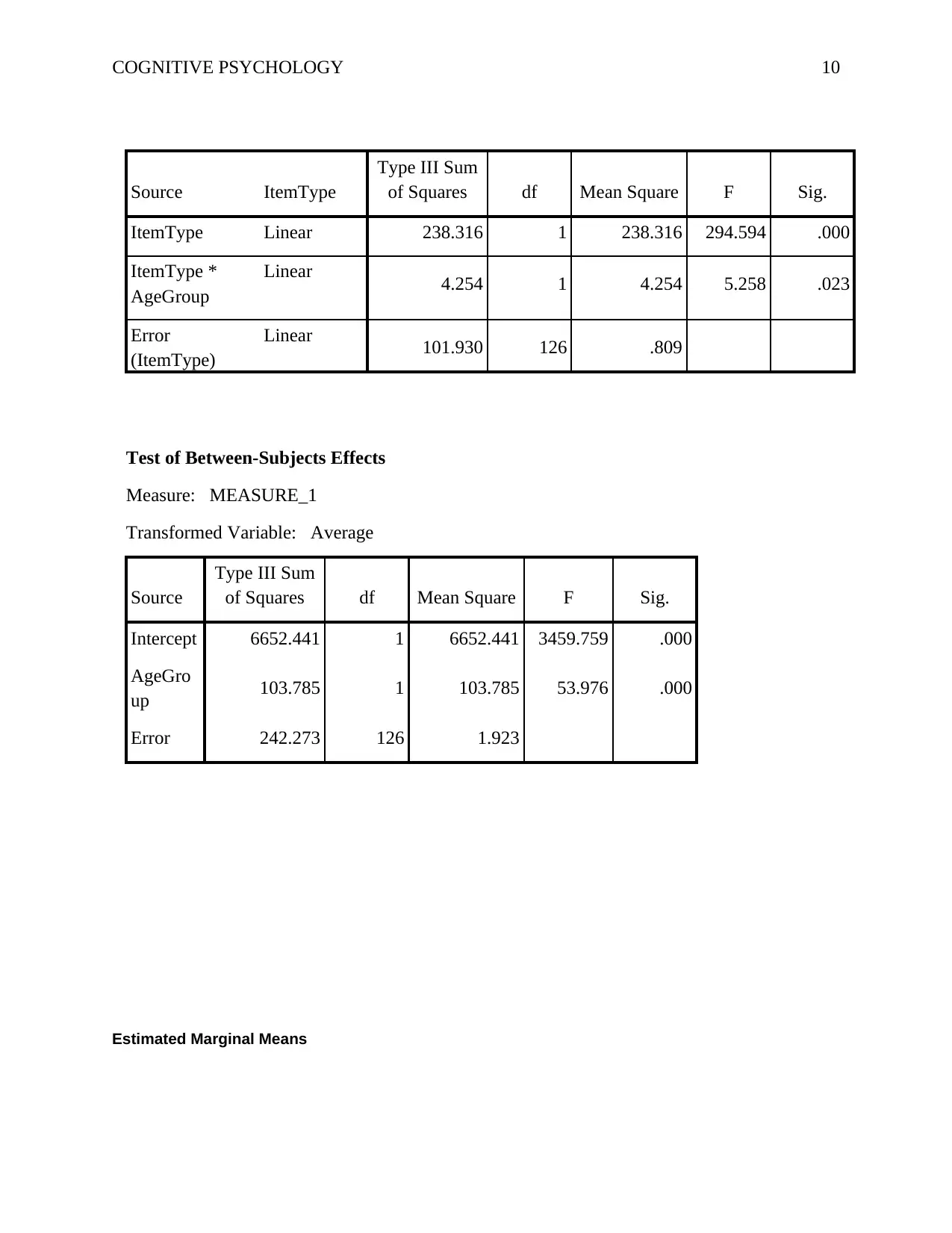
COGNITIVE PSYCHOLOGY 10
Source ItemType
Type III Sum
of Squares df Mean Square F Sig.
ItemType Linear 238.316 1 238.316 294.594 .000
ItemType *
AgeGroup
Linear 4.254 1 4.254 5.258 .023
Error
(ItemType)
Linear 101.930 126 .809
Test of Between-Subjects Effects
Measure: MEASURE_1
Transformed Variable: Average
Source
Type III Sum
of Squares df Mean Square F Sig.
Intercept 6652.441 1 6652.441 3459.759 .000
AgeGro
up 103.785 1 103.785 53.976 .000
Error 242.273 126 1.923
Estimated Marginal Means
Source ItemType
Type III Sum
of Squares df Mean Square F Sig.
ItemType Linear 238.316 1 238.316 294.594 .000
ItemType *
AgeGroup
Linear 4.254 1 4.254 5.258 .023
Error
(ItemType)
Linear 101.930 126 .809
Test of Between-Subjects Effects
Measure: MEASURE_1
Transformed Variable: Average
Source
Type III Sum
of Squares df Mean Square F Sig.
Intercept 6652.441 1 6652.441 3459.759 .000
AgeGro
up 103.785 1 103.785 53.976 .000
Error 242.273 126 1.923
Estimated Marginal Means
Paraphrase This Document
Need a fresh take? Get an instant paraphrase of this document with our AI Paraphraser
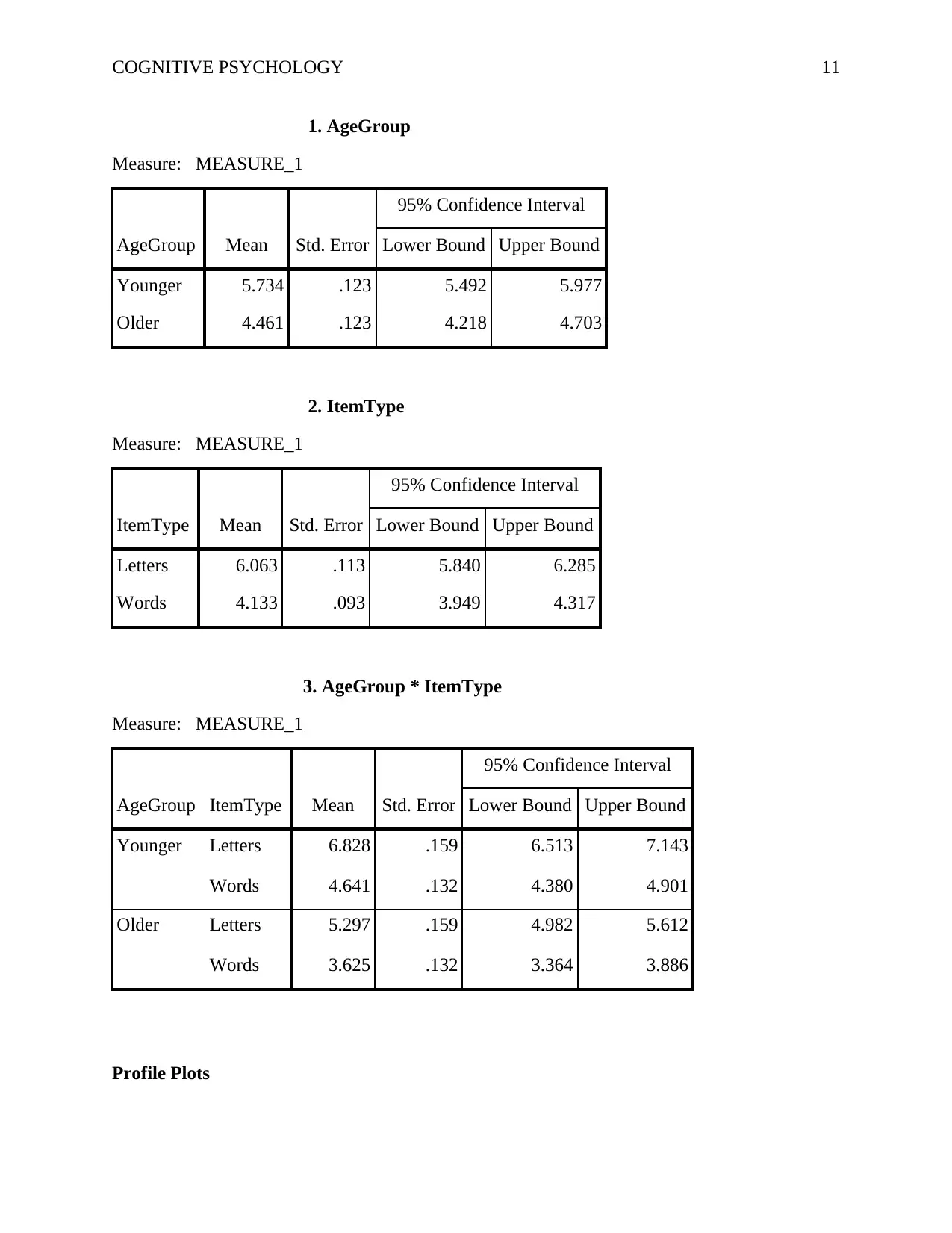
COGNITIVE PSYCHOLOGY 11
1. AgeGroup
Measure: MEASURE_1
AgeGroup Mean Std. Error
95% Confidence Interval
Lower Bound Upper Bound
Younger 5.734 .123 5.492 5.977
Older 4.461 .123 4.218 4.703
2. ItemType
Measure: MEASURE_1
ItemType Mean Std. Error
95% Confidence Interval
Lower Bound Upper Bound
Letters 6.063 .113 5.840 6.285
Words 4.133 .093 3.949 4.317
3. AgeGroup * ItemType
Measure: MEASURE_1
AgeGroup ItemType Mean Std. Error
95% Confidence Interval
Lower Bound Upper Bound
Younger Letters 6.828 .159 6.513 7.143
Words 4.641 .132 4.380 4.901
Older Letters 5.297 .159 4.982 5.612
Words 3.625 .132 3.364 3.886
Profile Plots
1. AgeGroup
Measure: MEASURE_1
AgeGroup Mean Std. Error
95% Confidence Interval
Lower Bound Upper Bound
Younger 5.734 .123 5.492 5.977
Older 4.461 .123 4.218 4.703
2. ItemType
Measure: MEASURE_1
ItemType Mean Std. Error
95% Confidence Interval
Lower Bound Upper Bound
Letters 6.063 .113 5.840 6.285
Words 4.133 .093 3.949 4.317
3. AgeGroup * ItemType
Measure: MEASURE_1
AgeGroup ItemType Mean Std. Error
95% Confidence Interval
Lower Bound Upper Bound
Younger Letters 6.828 .159 6.513 7.143
Words 4.641 .132 4.380 4.901
Older Letters 5.297 .159 4.982 5.612
Words 3.625 .132 3.364 3.886
Profile Plots

COGNITIVE PSYCHOLOGY 12
⊘ This is a preview!⊘
Do you want full access?
Subscribe today to unlock all pages.

Trusted by 1+ million students worldwide
1 out of 23
Related Documents
Your All-in-One AI-Powered Toolkit for Academic Success.
+13062052269
info@desklib.com
Available 24*7 on WhatsApp / Email
![[object Object]](/_next/static/media/star-bottom.7253800d.svg)
Unlock your academic potential
Copyright © 2020–2025 A2Z Services. All Rights Reserved. Developed and managed by ZUCOL.





